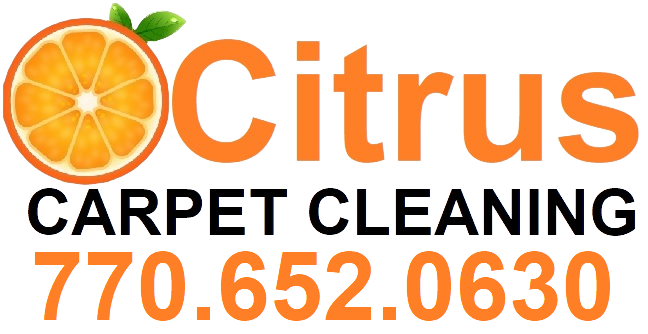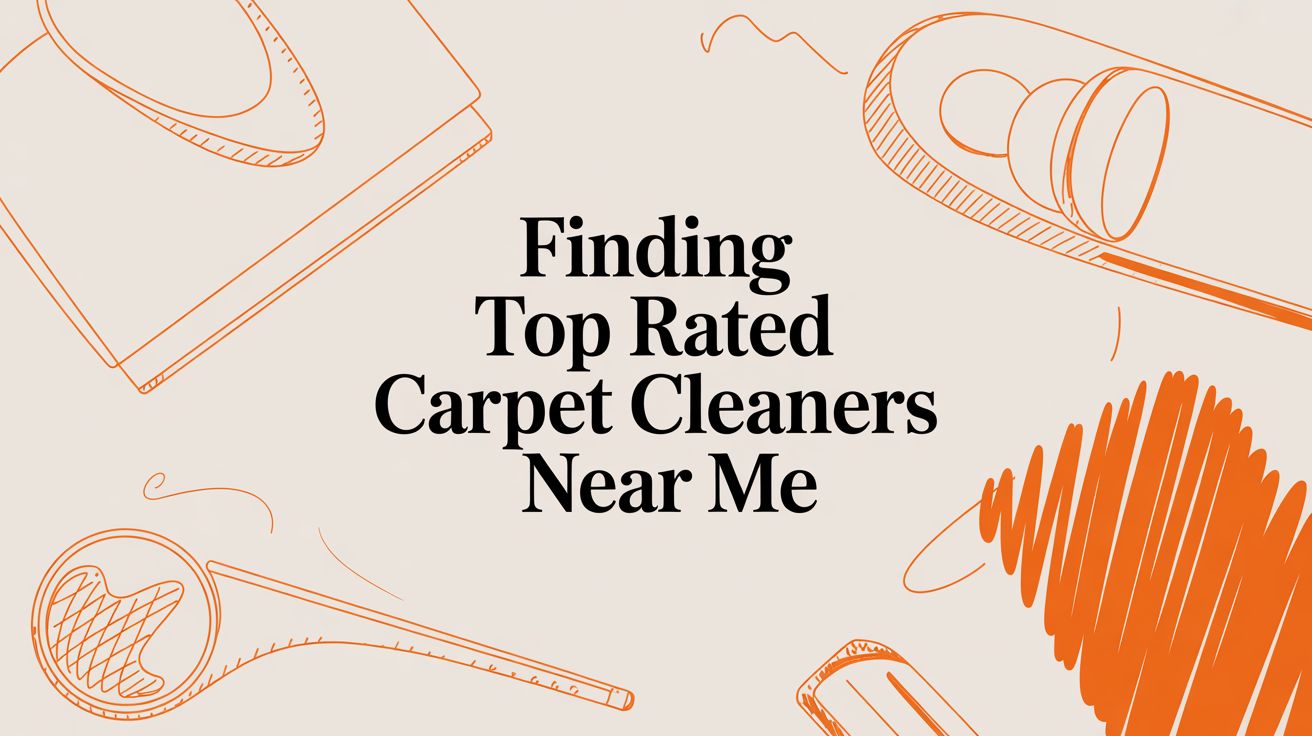When you start searching for top rated carpet cleaners near me, you'll quickly realize that star ratings only tell part of the story. The truly great local services are the ones that nail three key things: IICRC certification, transparent pricing, and a long history of happy customers who rave about their results and professionalism. These are your non-negotiables.
How to Quickly Vet Local Carpet Cleaners
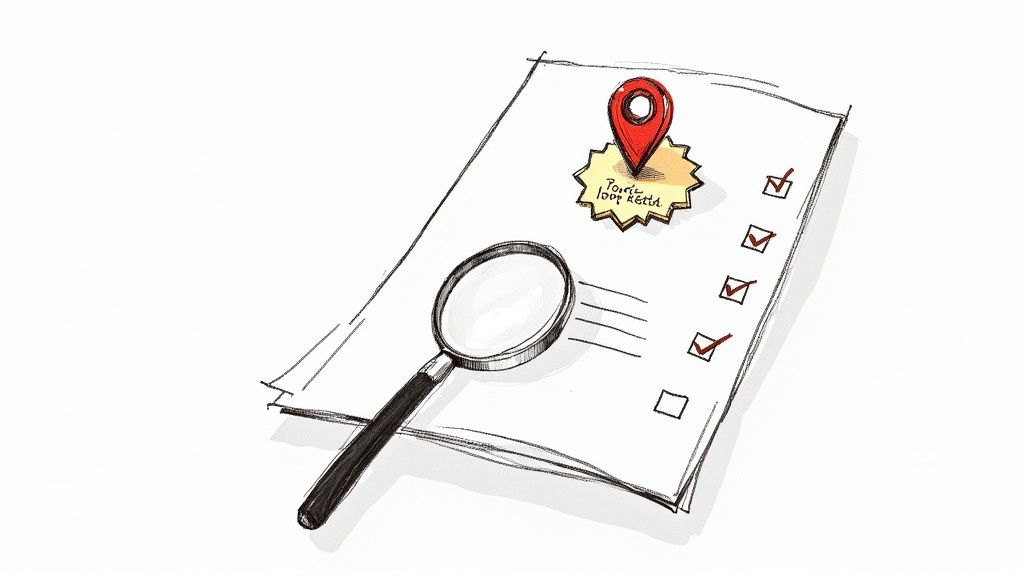
Finding a carpet cleaner you can trust doesn't have to be a shot in the dark. There's a simple framework I've used for years that cuts right through the marketing fluff.
Check Their Credentials And Insurance
First things first, verify their credentials and make sure they are fully insured. This isn't just a formality—it’s what protects your home from accidental damage. A company that’s proud to show off its qualifications is one that’s confident in its skills.
Get an “EXACT-imate,” Not a Vague Quote
Next, pay close attention to how they handle pricing. Do they give you a clear, upfront quote, or is it vague and full of potential add-ons? A trustworthy company will give you an "EXACT-imate," not a bait-and-switch estimate that mysteriously doubles once they're in your home. This is a huge part of what defines true customer service excellence, and it’s a trait you’ll find in every top-rated provider.
Look for an Effective (And Proven) Process
Finally, look for signs that they have a proven, effective cleaning process. I'm a big fan of low-moisture cleaning methods, for example, because they offer much faster dry times and don't leave behind that sticky soap residue that makes stains reappear a week later. It's a small detail that makes a huge difference.
A top-rated cleaner doesn't just clean your carpets. They deliver peace of mind through professionalism, transparent practices, and a genuine commitment to making you happy, from the first call to the final walkthrough.
To make this even easier, I've put together a quick checklist you can use. Run any company you're considering through these points before you even pick up the phone.
Quick Vetting Checklist for Carpet Cleaners
| Vetting Criteria | What to Look For | Why It's a Red Flag If Missing |
|---|---|---|
| IICRC Certification | A logo or mention on their website. This is the industry gold standard for training and knowledge. | Lack of certification can mean untrained technicians and outdated, ineffective cleaning methods. |
| Proof of Insurance | A statement confirming they are fully licensed and insured for residential work. | You could be on the hook for any accidental damage to your property, from a broken lamp to over-wet carpets. |
| Transparent Pricing | An upfront, itemized quote ("EXACT-imate") with no hidden fees. They should guarantee the price. | Vague estimates almost always lead to surprise charges for "deep cleaning" or "spot treatment" later on. |
| Positive, Detailed Reviews | Reviews that mention specifics: punctuality, technician's name, great results on tough stains, etc. | Generic, one-word reviews or a complete lack of feedback could signal an inexperienced or unreliable company. |
This simple process will help you weed out the bad apples and build a solid shortlist of reliable pros. For a deeper dive, our guide on how to make choosing a carpet cleaner stress-free has even more helpful tips.
Reading Between the Lines of Customer Reviews
A five-star rating is a great starting point, but let’s be honest, the real story is always hiding in the comments. When you're trying to find the top-rated carpet cleaners near me, learning how to dissect what people are actually saying is your best move.
Vague praise like "great job" is nice, but it doesn't really tell you anything useful.
What you're looking for are the details. Does a reviewer mention the technician, maybe even by name? Do they talk about a specific, nightmare stain—like the dog had an accident or someone spilled red wine—that the company actually got out? Those specifics are gold. They tell you the experience was real and memorable enough to write about.
Spotting the Patterns (Good and Bad)
As you scroll through the reviews, start looking for themes. It’s all about the patterns. If you see ten different people saying the technician showed up on time and was super professional, you can bet they run a tight ship.
On the flip side, if you notice a few comments about surprise fees or an aggressive upsell once the technician is in the door, that’s a massive red flag.
Here are a few common things I always look for:
- Punctuality: Did the crew actually arrive during the scheduled window? Time is money.
- Professionalism: Was the tech polite? Did they respect the customer’s home?
- Stain Removal: This is the big one. Do people rave about their success with tough spots?
- Pricing Honesty: Do the comments back up the idea that the final price matched the quote? No games.
Look, a single negative review isn't a dealbreaker, especially if a company has hundreds of glowing ones. What you're hunting for is the overall trend—the story being told by most customers. A consistent pattern of excellence is what you can really trust.
How They Handle the Bad Stuff
Don't just skip over the one- and two-star reviews. They can be incredibly revealing, especially when you look at how the company responds.
A professional, calm, solution-focused reply to a complaint shows they care and take accountability. If there’s no response at all, or worse, a defensive and angry one? That tells you just as much about their customer service as the original complaint.
To get the full picture, it's helpful to understand why online reviews are crucial for local businesses and the effort that goes into getting them. It gives you a much better feel for a company's reputation before you even think about picking up the phone.
Why You Should Never Hire a Cleaner Without IICRC Certification and Proper Insurance
It's tempting to get wowed by those dramatic before-and-after pictures when you’re looking for a good carpet cleaner. But honestly, the most important stuff has nothing to do with pretty photos. It's the boring-but-critical details that protect you before a single machine enters your home: certification and insurance.
These aren’t just fancy extras for a company to brag about. They're your absolute first line of defense against a shoddy job or, even worse, a costly accident in your home.
Think about it. You wouldn't hire an electrician who wasn't licensed to mess with your wiring, right? Of course not. The same exact logic applies here. Letting an uncertified and uninsured cleaner loose on your carpets is a huge gamble with your property.
The IICRC: A Cleaner's "Board Certification"
The IICRC (Institute of Inspection, Cleaning and Restoration Certification) is pretty much the gold standard for our industry. When a technician is IICRC-certified, it tells you they've gone through some serious training and passed exams on how to properly handle different carpet fibers, tackle specific stains, and use their equipment the right way.
It’s your guarantee they understand the science behind cleaning, not just how to push a wand back and forth. A certified pro knows that a delicate wool rug needs a totally different approach than a durable nylon carpet, and they have the know-how to prevent disasters like colors bleeding or, god forbid, the carpet shrinking.
A company that hasn't bothered with IICRC certification is basically admitting they haven't invested in their own professional education. In my experience, that's a massive red flag that usually goes hand-in-hand with outdated methods and a much higher risk of ruining your floors.
Insurance Is Your Financial Safety Net
Look, even the best of us can have an off day. Accidents happen. Imagine a cleaning machine springs a leak and water floods your hardwood floors, or a priceless heirloom gets knocked over and damaged. If that company doesn't have the right insurance, you could be the one stuck paying for thousands in repairs.
A legitimate, professional carpet cleaning business will always carry, at the very least, general liability insurance. This is what covers property damage or injuries that might happen while they're working in your home.
And don't just take their word for it. Ask to see their certificate of insurance. Any real pro will be happy to show you. It's one of the clearest signs that separates the true professionals from the fly-by-night operators and gives you total peace of mind. Without it, you're flying blind and completely unprotected.
Choosing the Right Carpet Cleaning Method for Your Home
When you start looking for top rated carpet cleaners near me, one of the biggest things to consider is the actual technique they use to clean. It's not a one-size-fits-all situation, and the best method really depends on your carpet, your lifestyle, and what you need cleaned. This choice impacts everything, from how long it takes your carpet to dry to how long it stays looking fresh.
You'll mainly run into two camps: Hot Water Extraction (what most people call steam cleaning) and various types of Low-Moisture Systems. Each has its own pros and cons, and knowing the difference will help you hire the right company.
Hot Water Extraction vs. Low-Moisture Cleaning
Hot Water Extraction is the old-school method many of us grew up with. A machine blasts a mix of hot water and cleaning solution deep into the carpet fibers, and then a powerful vacuum immediately sucks it all back up. It’s fantastic for a really deep clean on heavily soiled carpets, and a lot of the big carpet manufacturers still recommend it.
The problem? The drying time. It can take anywhere from six to a whopping 24 hours, or even longer. That's a huge inconvenience, and if the job isn't done perfectly, all that moisture can lead to mold, mildew, or a pesky "wicking" issue where deep stains reappear as the carpet dries.
This is a big reason why the industry is changing. The global carpet cleaning market is expected to hit $3.93 billion by 2030, and a huge driver of that growth is the move toward smarter, more sustainable methods that homeowners are asking for.
That’s where Low-Moisture Cleaning, often called Very Low Moisture (VLM), comes in. This approach uses specialized equipment and cleaning compounds that require way less water.
- Dries Fast: This is the biggest win for most people. Your carpets are usually dry in just 1-2 hours, which is a lifesaver for busy homes with kids and pets.
- No Sticky Stuff Left Behind: VLM methods avoid the soapy detergents that can leave a sticky residue, which is notorious for attracting more dirt. This means your carpets stay clean longer.
- A Greener Choice: Using up to 90% less water than traditional methods makes it a much more eco-friendly option.
If you want to dive deeper into the nitty-gritty, you can learn more about the differences between VLM and steam cleaning in our detailed article.
This simple decision tree is a great starting point for vetting any potential cleaner, zeroing in on the absolute must-haves: proper certification and insurance.
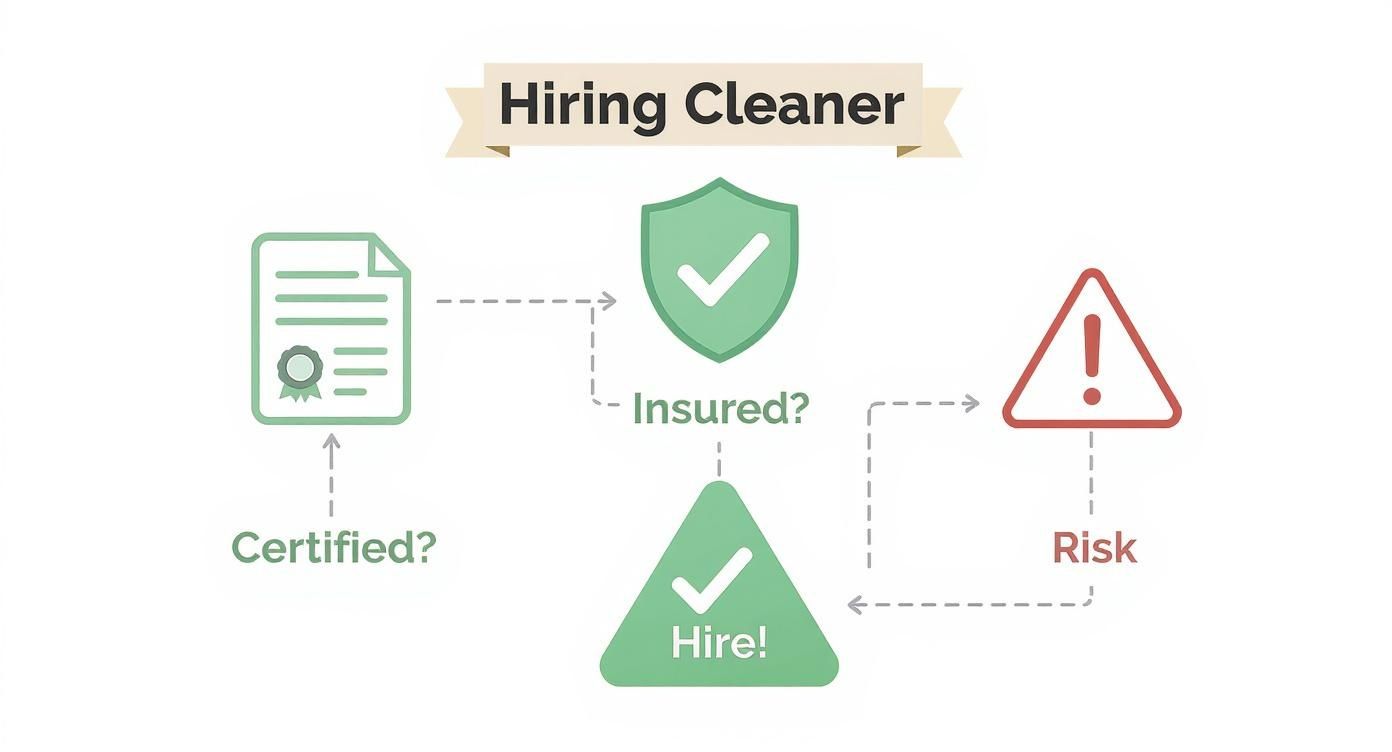
As you can see, the safest and fastest way to find a pro you can trust is to check their credentials first. Once you've confirmed they're legit, asking about their cleaning method is the next logical step to make sure they're the right fit for you and your home.
How to Get a Transparent and Accurate Quote
In the world of carpet cleaning, an unusually low price is almost always a red flag, not a great deal. When you're searching for top rated carpet cleaners near me, one of the most important things you can do is lock in a transparent and accurate quote. This is your best defense against the classic bait-and-switch.
A legitimate, honest company will never be vague about costs. They should be able to give you a firm price based on your room sizes or total square footage, not some loose "estimate" that magically inflates once they're in your home.
Uncovering Hidden Fees and Common Pricing Models
You're likely to run into two main pricing models: per-room and per-square-foot. Per-room pricing seems simple enough, but you have to ask what they consider a "room." Some companies cap it at 200 square feet, meaning your large living room suddenly becomes two rooms on the final bill. Sneaky, right?
Per-square-foot pricing is usually more precise, but the real danger with any model is the hidden fees.
Never assume a quote is all-inclusive. Some companies nickel-and-dime you for services that should be standard, turning a cheap initial price into a shockingly expensive final invoice. Always get everything confirmed in writing.
You need to specifically ask about potential upcharges before you agree to anything. Here are the big ones to clarify:
- Stain Treatments: Is there an extra charge for everyday spots like food spills or pet accidents?
- Furniture Moving: Do they expect you to move everything, or is moving a sofa or coffee table included?
- "Deep Cleaning": Is the price they quoted for a light, standard cleaning or the heavy-duty service your high-traffic areas actually need?
Doing your homework here is more important than ever. The global carpet cleaner market was valued at USD 776.62 million in 2024 and is projected to hit USD 1.32 billion by 2033, a boom driven by people like you demanding effective, reliable service. You can learn more about the growth in the carpet cleaner market on Straits Research.
To truly compare quotes, you have to look at the total value, not just the bottom-line number. Compare their cleaning method, what kind of guarantee they offer, and exactly what services are included. For a clear breakdown of what you should expect, take a look at this guide on understanding professional carpet cleaning pricing. It’ll help you pick a company that delivers real results without any last-minute financial surprises.
Getting Your Home Ready for a Professional Carpet Cleaning
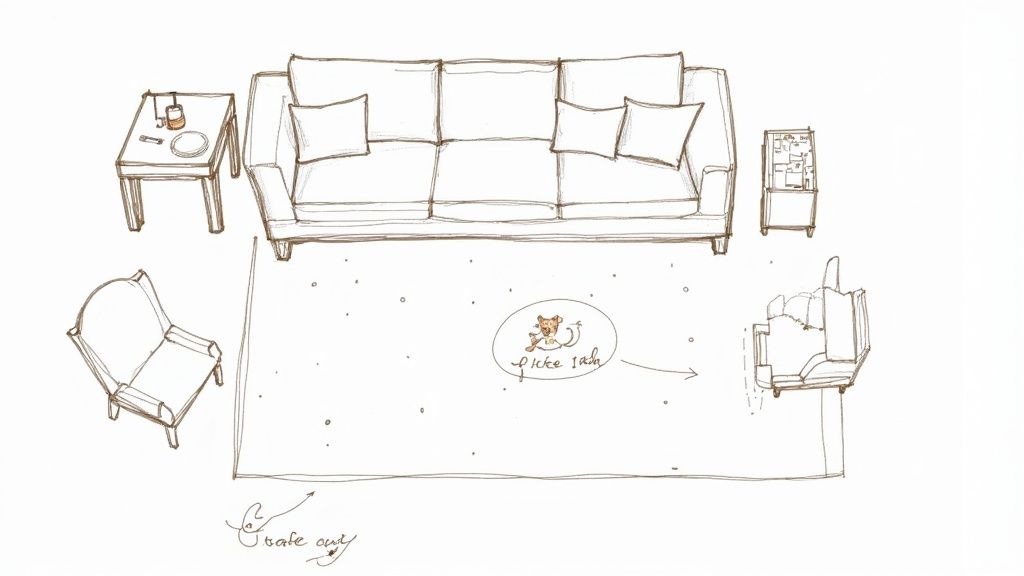
You've done the hard work of finding the best local pros and have your appointment on the books. Now what? Taking a few minutes to prep your space can make a world of difference. A little tidying up ensures the technicians can get straight to work and focus their time on what really matters: deep cleaning your carpets.
First thing's first: give all the areas they'll be cleaning a good, thorough vacuuming. This is a crucial step. It pulls up all the loose dirt, crumbs, and that seemingly endless supply of pet hair. Think of it like clearing the battlefield so their professional-grade equipment can attack the deep-down, ground-in grime more effectively.
A Quick Home Prep Checklist
With the vacuuming done, it's time to clear the decks. The main goal here is to give the cleaning crew an open, obstacle-free workspace.
- Move smaller furniture out of the rooms being cleaned. Things like end tables, floor lamps, ottomans, and those little decorative baskets can all be temporarily relocated.
- Clear off any breakables from tables or shelves that might get bumped or need to be shifted. Picture frames, vases, and collectibles should be tucked away safely.
- Handle any floor-length drapes by simply draping them over the windowsill or curtain rod. This little trick keeps them from getting damp or caught in the equipment.
It's also a really good idea to find a safe, closed-off space for pets and kids. This keeps them away from the hot water and equipment, and it lets the technicians move freely without worrying about tripping over a furry friend.
Finally, do a quick walkthrough before they arrive. Take a mental note of any specific trouble spots you're worried about. When the crew gets there, you can point out that stubborn coffee stain in the living room or the high-traffic lane by the back door. This helps them know exactly where to focus their efforts for the best possible results.
Got Questions? We've Got Answers
Even after you've done your homework, a few last-minute questions usually pop up before you book a cleaning. Let's walk through the most common ones I hear so you can feel totally confident in your decision.
How Often Should I Really Get My Carpets Cleaned?
For a typical household, most carpet manufacturers will tell you to get a professional cleaning every 12 to 18 months. That's a solid baseline.
But let's be real—life isn't always "typical." If you've got pets, kids, or anyone in the house with allergies, you'll want to bump that up to every 6 to 9 months. It makes a huge difference in your home's air quality and keeps things looking fresh.
Is It True That Cleaning Makes Carpet Get Dirty Faster?
That's an old myth, but it comes from a real place. Decades ago, carpet cleaners used heavy, soapy detergents that left behind a sticky, gunky residue. And what does sticky residue do? It grabs onto new dirt like a magnet.
Thankfully, times have changed. Modern methods, especially low-moisture techniques with residue-free solutions like the citrus-based cleaner we use, completely avoid this problem. Your carpet actually stays clean longer because there’s nothing left behind to attract grime.
A quality cleaning does more than just lift dirt; it restores your carpet's soft texture without leaving a trace of residue. When we're done, your carpet should feel soft and fluffy under your feet, never stiff or sticky.
Remember, a clean carpet is more than just a good look—it's a cornerstone of a healthy, comfortable home.
Ready for carpets that feel as good as they look, without being wet for days? Citrus Carpet Cleaning Buford uses a low-moisture, citrus-based system that’s safe for the whole family and dries in just 1-2 hours. Get your free, guaranteed "EXACT-imate" by visiting our website at https://citruscarpetcleaningatlanta.com.
